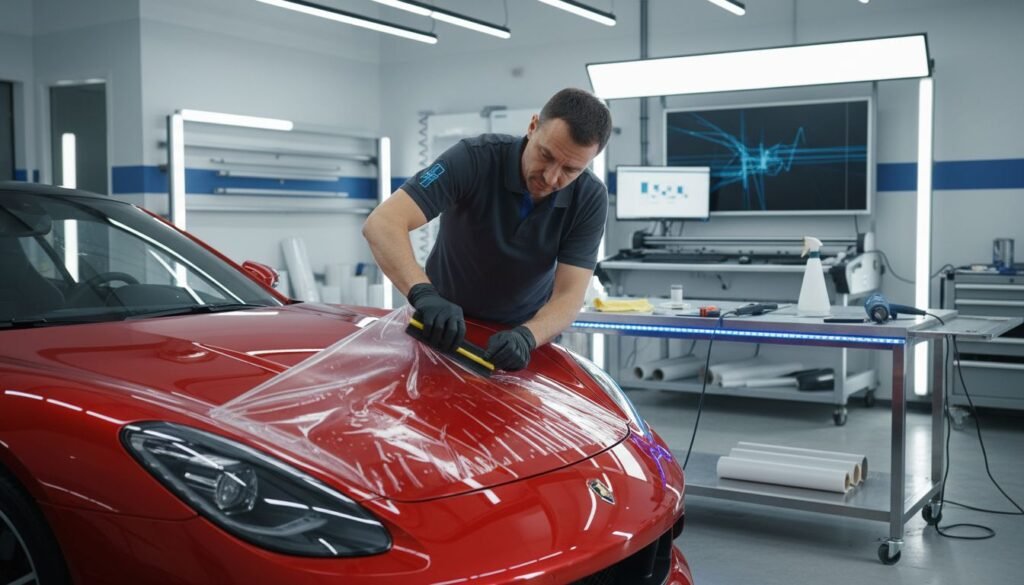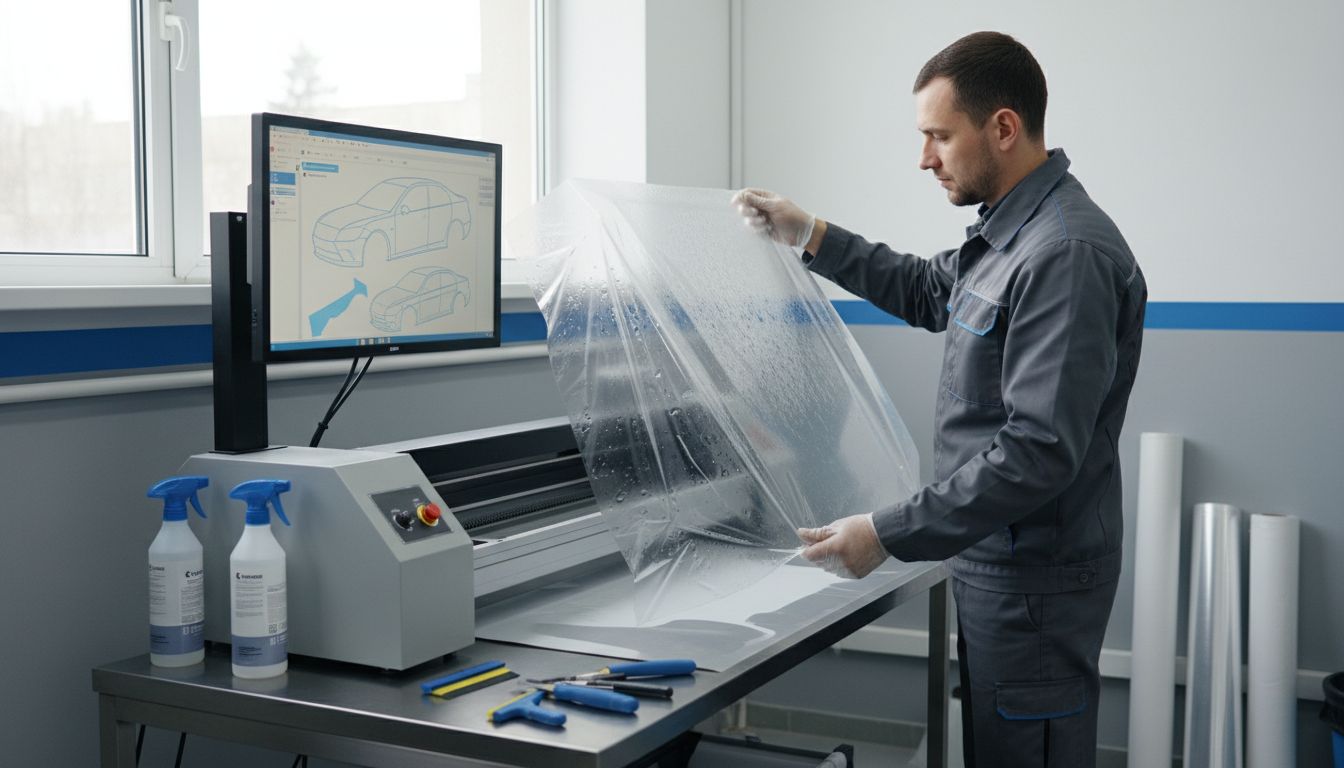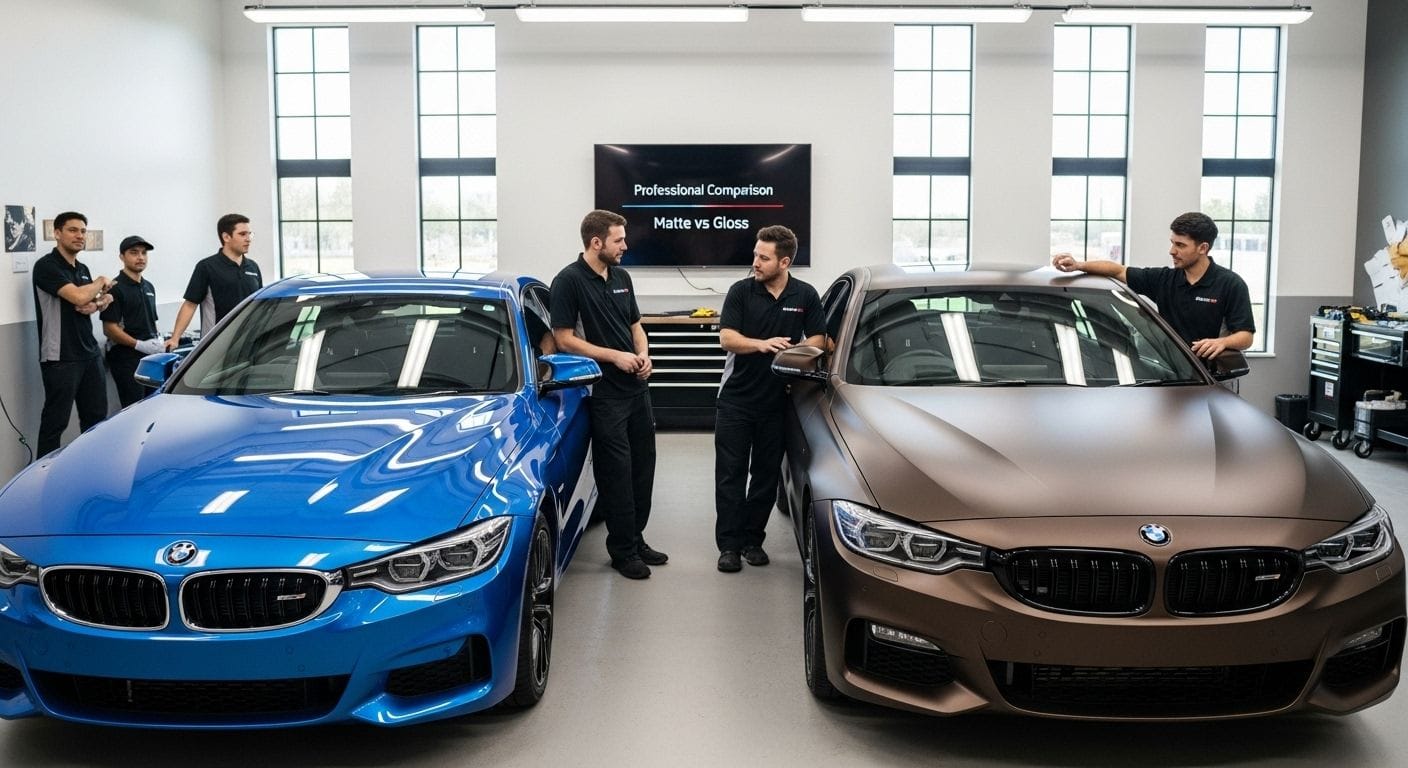
Scratches, fading, and chips threaten even the most careful drivers, yet professional solutions have changed the game. Modern car paint protection films now last up to 10 years, far outpacing traditional waxes or sealants. Keeping a car looking new is no longer guesswork, thanks to breakthroughs in surface technology. Whether battling harsh sun, road debris, or daily wear, today’s protection options offer advanced defense that preserves both appearance and value.
Table of Contents
- Defining Car Paint Protection Solutions
- Types of Paint Protection Films and Coatings
- How Paint Protection Products Work
- Installation Processes and Professional Tools
- Costs, Risks, and Common Mistakes
Key Takeaways
| Point | Details |
|---|---|
| Understanding Protection Types | Different car paint protection solutions include Paint Protection Film, Ceramic Coating, and Nano Coating, each offering unique benefits and lifespans. |
| Installation Significance | Professional installation is crucial for optimal performance, requiring precision in surface preparation and application techniques. |
| Cost Considerations | Investment decisions in paint protection films must balance cost, film quality, and expected durability to ensure effective long-term protection. |
| Common Mistakes | Avoid common installation errors such as improper surface preparation and incorrect techniques to maintain film integrity and performance. |
Defining Car Paint Protection Solutions
Car paint protection solutions are specialised treatments designed to shield automotive surfaces from environmental damage, scratches, and wear. According to Wikipedia, these protective layers are critical for maintaining a vehicle’s aesthetic appeal and durability in challenging conditions.
These solutions typically encompass several core technologies, including:
Here’s a comparison of the main types of car paint protection solutions:
| Solution Type | Key Features | Typical Lifespan |
|---|---|---|
| Paint Protection Film | Physical barrier Self-healing UV resistant | 5-10 years |
| Ceramic Coating | Chemical bonding Hydrophobic Glossy finish | 2-5 years |
| Nano Coating | Enhanced environmental resistance Microscopic layers | 1-3 years |
- Paint Protection Film (PPF): A transparent polyurethane film applied directly to vehicle surfaces
- Ceramic Coatings: Liquid polymer treatments that chemically bond with factory paint
- Nano Coatings: Microscopic protective layers offering enhanced environmental resistance
Professional installers understand that comprehensive paint protection goes beyond simple surface treatments.
 Understanding Paint Protection Film Lifespan: Insights for Professionals 2025 highlights that modern solutions are engineered to provide multi-layered defence against UV rays, chemical contaminants, minor abrasions, and environmental pollutants.
Understanding Paint Protection Film Lifespan: Insights for Professionals 2025 highlights that modern solutions are engineered to provide multi-layered defence against UV rays, chemical contaminants, minor abrasions, and environmental pollutants.
From Muralplast research, we know these protective technologies are designed to safeguard surfaces against diverse environmental challenges, making them essential for maintaining vehicle appearance and structural integrity. Professional installers recognise that selecting the right protection method depends on specific environmental conditions, vehicle usage, and client requirements.
Types of Paint Protection Films and Coatings
Paint protection films represent a sophisticated range of automotive surface protection technologies, each designed to meet specific performance and aesthetic requirements. According to Final Approach Detailing, these films come in multiple variations that cater to diverse professional installer needs.
The primary types of paint protection films include:
- Gloss Finish Films: Opticle Defense Clear Film providing a high-shine, transparent protective layer
- Matte Finish Films: Opticle Defense Matte Film offering a sophisticated satin-like surface texture
- Self-Healing Films: Advanced films that automatically repair minor scratches when exposed to heat
PPF Versus Ceramic Coating: Best Choice for Automotive Pros 2025 highlights that professional installers must consider multiple factors when selecting paint protection films. These considerations include durability, aesthetic preferences, environmental exposure, and client expectations.
Beyond traditional films, modern paint protection technologies now encompass hybrid solutions that combine multiple protective attributes. These advanced films not only shield against physical damage but also provide UV resistance, chemical protection, and enhanced visual appeal. Professional installers recognise that selecting the right film requires a nuanced understanding of each client’s specific automotive protection requirements.
How Paint Protection Products Work
Paint protection technologies represent a sophisticated molecular approach to preserving automotive surfaces against environmental damage and wear. According to PCI Magazine, recent nanotechnology advancements have revolutionized these protective solutions, introducing remarkable capabilities like hydrophobic properties and self-healing mechanisms.
The core functional mechanisms of paint protection products include:
- Chemical Bonding: Molecular-level adhesion to vehicle paint surfaces
- Barrier Protection: Creating an invisible shield against contaminants
- Self-Healing Properties: Automatically repairing minor scratches
How Does PPF Work? Guide for Car Care Pros 2025 explains that professional-grade protection films work through advanced thermoplastic polyurethane (TPU) technologies. These films create a dynamic protective layer that responds to environmental conditions while maintaining the vehicle’s aesthetic integrity.
From PPFAD, we understand that cutting-edge paint protection films like Avery Dennison’s Supreme Protection Films utilize high scratch-resistant top-coated TPU. These innovative solutions provide self-healing capabilities at both ambient temperatures and with applied heat, demonstrating how modern automotive protection goes far beyond traditional waxing or simple coating methods. Professional installers recognize that these technologies offer not just protection, but a comprehensive approach to maintaining a vehicle’s pristine appearance.
Installation Processes and Professional Tools
Professional paint protection film installation requires precision, specialized techniques, and advanced technological tools. According to Wikipedia, the application of protective coatings involves sophisticated methods that enhance scratch resistance and maintain vehicle appearance.
Key steps in the professional installation process include:
- Surface Preparation: Thorough cleaning and decontamination of vehicle surfaces
- Precise Cutting: Using computer-aided design (CAD) pattern technologies
- Careful Application: Minimizing air bubbles and ensuring perfect alignment
- Heat Activation: Utilizing controlled heat to activate self-healing properties
Best PPF Software 2025: Top Picks for Auto detailing businesses highlights the critical role of advanced software in streamlining the installation process. Professional installers now rely on digital tools that provide precise pre-cut patterns, reducing material waste and improving overall efficiency.

Drawing from Electrostatic Spray Techniques, modern installation approaches incorporate advanced coating deposition technologies. Professional tools now include high-precision cutting machines, infrared heat guns, and computerized design software that allow for microscopic accuracy in film application. This technological evolution means installers can achieve near-perfect results, protecting vehicle surfaces with unprecedented precision and reliability.
Costs, Risks, and Common Mistakes
Paint protection film investments require careful consideration of multiple financial and technical factors. According to Final Approach Detailing, the costs can fluctuate significantly based on film type and vehicle dimensions, making strategic planning essential for professional installers.
Common risks and potential mistakes in paint protection film application include:
- Improper Surface Preparation: Leading to poor adhesion and film failure
- Low-Quality Film Selection: Compromising long-term protection effectiveness
- Incorrect Installation Techniques: Causing air bubbles and misalignment
- Inadequate Maintenance: Reducing film performance and lifespan
Top PPF Brands in 2025: A Professional’s Buying Guide emphasizes the importance of understanding film technology variations. Professional installers must navigate complex trade-offs between budget constraints and performance expectations.
From PDR TX Smart Auto Repair, we understand that different film technologies like Thermoplastic Hybrid (TPH) and Thermoplastic Polyurethane (TPU) present unique cost-performance profiles. Budget-friendly options might sacrifice durability, while premium films offer superior protection but at higher price points. Successful professionals balance these considerations, selecting films that provide optimal value for their specific client base and environmental conditions.
Elevate Your Car Paint Protection with Precision Cutting Software
Protecting car paint requires not only the right film or coating but also flawless application for long-lasting results. The article highlights challenges like choosing the perfect paint protection film type, ensuring precise installation, and avoiding costly mistakes such as improper surface prep or film misalignment. Professional installers and car enthusiasts alike face the goal of achieving a perfect finish while minimising material waste and maintaining the vehicle’s pristine appearance.
Experience how the Paint Protection Film – AEONCUT PPF Pre-cut Cutting software can solve these key challenges with its advanced pre-cut pattern library. Designed for accuracy and efficiency, AEONCUT streamlines installation, reduces errors, and helps you deliver superior paint protection every time.

Empower your paint protection projects today by exploring AEONCUT’s smart auto-cutting tools and AI-driven layouts. Don’t let installation hurdles compromise your work. Visit https://aeoncutsw.com to start your free trial and join professionals who trust AEONCUT to protect vehicles with precision. For further insights, explore our Featured – AEONCUT PPF Pre-cut Cutting software section and take the next step toward flawless results.
Frequently Asked Questions
What are car paint protection solutions?
Car paint protection solutions are specialized treatments designed to shield automotive surfaces from environmental damage, scratches, and wear, maintaining a vehicle’s aesthetic appeal and durability.
What are the main types of paint protection solutions?
The main types of paint protection solutions include Paint Protection Film (PPF), Ceramic Coating, and Nano Coating, each with distinct features and lifespans, ranging from 1 to 10 years.
How does a Paint Protection Film (PPF) work?
Paint Protection Film works by applying a transparent polyurethane film to vehicle surfaces, creating a physical barrier that provides self-healing properties and UV resistance to protect against scratches and contaminants.
What common mistakes should be avoided during paint protection film installation?
Common mistakes include improper surface preparation, using low-quality films, incorrect installation techniques leading to air bubbles, and inadequate maintenance that can reduce the film’s performance and lifespan.
Recommended
- How Does PPF Work? Guide for Car Care Pros 2025 – AEONCUT PPF Pre-cut Cutting software
- Top Paint Protection Film Benefits for Auto Professionals 2025 – AEONCUT PPF Pre-cut Cutting software
- Clear Bra vs PPF: Key Differences for Detailing Pros 2025 – AEONCUT PPF Pre-cut Cutting software
- Clear Bra vs PPF: Key Differences for Detailing Pros 2025 – AEONCUT PPF Pre-cut Cutting software
- Auto Detailing Steps Explained: A Complete Guide
- Auto Detailing Explained: Value, Protection, & Resale


